Yuri Sychov
Every day around 9 million passengers on Moscow's Metro become unwitting visitors to a unique "stone show". The idea of creating a relaxing environment underground through the extensive use of decorative stone cladding and flooring was first put into practice in 1935. Today there are 162 stations and stone decor is featured at most of them. Yuri Sychov reports.
Every day some 9 million people, descending to 162 stations on the Russian capital's underground railway system (the Moscow Metro), become as it were unwitting visitors to a "Museum of Stone Pictorial Art". The vast majority take what is on permanent display for granted. Nevertheless the 800,000 m2 or so of highly decorative marble and other types of stone on the walls, floors and specific features of the stations and passageways is known to have a highly beneficial effect on the human psyche.
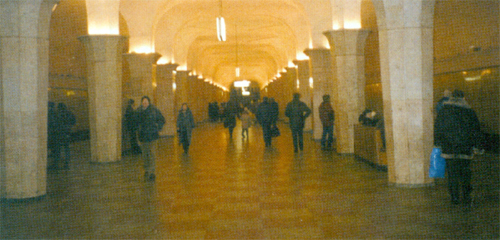
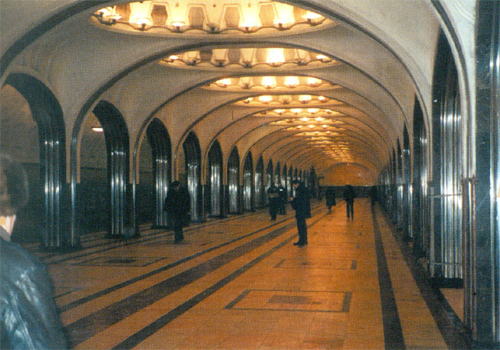
The tradition of facing underground railway stations with marble can be traced back to the beginnings of this form of transport beneath cities whose streets on the surface could not cope with the volume of vehicles. In the early 1930s the Soviet government and it is said Joseph Stalin personally requested the designers of the proposed underground passenger transit system for Moscow to: "make the Metro the best appointed in the world, thereby demonstrating the superiority of the socialist system; the stations should have an illusion of 'daylight spaciousness'…". It has to be said that by and large, the architects and builders completely fulfilled the government's wishes.
The first stage
Running from Sokolniky to the Park of Culture, with an appendix from Lenin Library to Smolenskaya, the first stage of the Moscow Metro was opened on 15th May 1935. The astonished passengers, venturing below ground for the first time, were able to see 13 palatial stations decorated with marbles and granites from the Urals, Georgia and the Ukraine.
The building of the first line of the Metro gave a positive boost to the Soviet stone quarrying and processing industries, which at that time were in a very neglected state. White marble played a dominant role in the architecture of the first stations. The idea of course was to give the stations a feeling of lightness and elegance, to create an illusion of bright "daylight" conditions.
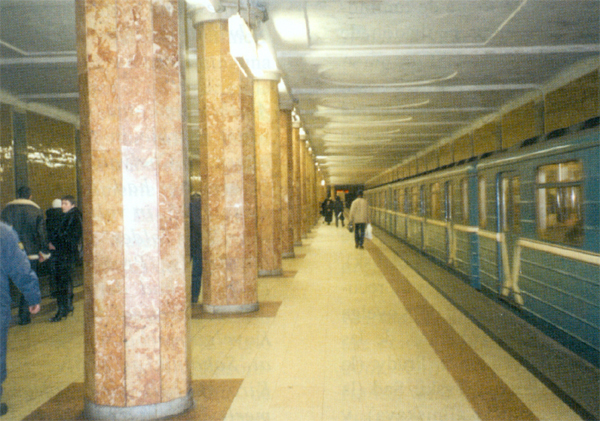
At this time the only volume source of white marble in the USSR was Koyelga quarry in Chelyabinsk region in the Urals. Quarrying had been undertaken here since 1925, in volumes of 500 - 700 m³ a year. Two "older" white marble sources in the Urals (Prokhorovo-Balandinsk and Polevsk) had derelict quarries which it was impractical to resurrect at the time. Koyelga marble was used to clad columns at Sokolniki, Chistiye Prudy (formerly Kirovskaya), Aleksandrovskii Sad (formerly Comintern, then Kalininskaya) and Okhotny Ryad stations, columns and passageway walls at Kropotinskaya (formerly Palace of Soviets) stations. Kropotinskaya Station is one of the most elegant on Line 1. It is said that initially, all the columns and walls (and the ceilings) were decorated with white plaster. It seems that the architects decided not to specify marble cladding because they thought it might detract from the station's "lightness". Some time later the decision was reversed and Koyelga marble tiles and panels were installed. The station lost none of its elegance, but the monotone "hospital whiteness" of the plaster was replaced by a natural material with hints of coloured tones and structure. Grey marbles for stations on the first line also came from the Urals. The biggest marble quarry in the country at the time, producing 1500 - 2000 m³ of blocks a year, was Ufalei quarry in Chelyabinsk region. Bluish-grey, wavy-striped Ufalei marble adorns the walls and columns of the platform halls at Sokolniki, Chistiye Prudy and Lubyanka (formerly Dzerzhinskii) stations. Another Urals marble, from Shabrovsk quarry in Sverdlovsk region, has a characteristic light grey cloudy patterning (it was used for tiling the walls at Smolensk Station). Yet another grey, or more accurately grey-black marble with white veins, extracted from Sadakhlo quarry in Georgia, was used to decorate elements of the columns at Okhotny Ryad Station.
When the first line of the Moscow Metro was being built, there was not a single working quarry producing coloured marble in the USSR. Attention turned to the Crimea, where sources of Upper Jurassic hard limestones were known. Quarrying was initiated specifically to supply the Metro project. The Crimean stones became the dominant coloured decorative materials used in underground vestibules on Line 1.
Crimean limestones have a history of local use since the mid-19th century. In the early 20th century, competition from imported Italian and Greek marbles caused local quarrying to cease. In 1933-34 that activity recommenced, at several sites to fulfil the Moscow Metro's needs. But there were problems with the size and quality of blocks from some sources and eventually only blocks from three quarries were accepted in Moscow. Rigorous selection won the day and the variegated Crimean limestones undoubtedly enhance the stations interiors giving their architecture a simple spiritual beauty, reminiscent of the colour of a late autumn day in the south.
A small quantity of coloured marble for the first line was obtained from old abandoned quarries: Nizhne-Tagil (Sapalskii) in the Urals and Shroshinskii in Georgia. Coloured marble from the Gazgan quarries in Uzbekistan was also used albeit to a very limited extent at some stations on Line 1. Later on Gazgan marble was to play a very important role in Metro decoration.
Because of the shortage of carbonate raw materials when Line 1 was being built, the majority of the walls of the pedestrian tunnels were clad with cheap cement tiles which looked out of place with their marble borders. The deficiency was also partly made up by not very decorative hard limestones and dolomites from Central Russia. The situation regarding siliceous decorative stones was considerably better.
Most of the granite for stations on Line 1 came from the Ukraine, where there was already an upturn in quarrying to build the V. I. Lenin Mausoleum. For some Metro stations greenish-grey Yantsevo granite from Zaporozhe region was the material of choice for f1ooring and stairs. In the author's opinion, the best example of the use of this material is in combination with bright red Tok granite from Dnepropetrovsk region: large tiles of alternating grey and red granite on the floor, laid in chess board fashion at Kropotinskaya Station, blend beautifully with the snow-white columns. Seven other granites from the Ukraine can be seen on stations of Line 1 .The only non-Ukrainian granite came from Kaarlakhtinsk quarry in Leningrad region (NW Russia). Floors paved with this highly attractive lilac-rose colour granite can be seen at Chistiye Prudy Station.
Phase 2
Construction of the next phase of the Metro (parts of the Zamoskvorets and Arbat-Pokrovsk lines) in 1935-38 coincided with preparations for the building of the Palace of the Soviets, which to a considerable degree stimulated further development of sources of decorative stone in different parts of the Soviet Union. Thus the palette of colours available for designers of the new Metro stations was significantly increased. Even today it can be said that in terms of the richness and variety of the decorative stones on display, the Second Line of the Moscow Metro is unrivalled in the whole world.
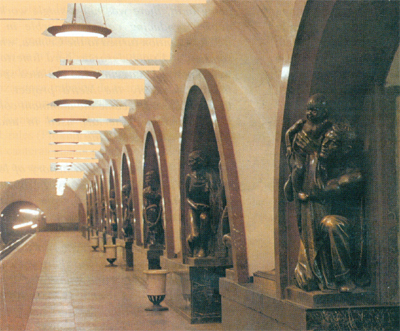
In addition to white marbles, now also yellowish, straw-coloured marble from Polevskoye quarry in the Urals and white semi-transparent marble with cloud-like patterning from Prokhorovo-Balandin quarry could be used. The former material was used in passageways at Teatralnaya (formerly Sverdlov Square) Station and for elements of the columns; the latter stone was used to decorate the central part of the hall at the same station, whilst solid pieces were used for the columns.
There was not enough Russian white marble to complete the work at Teatratnaya Station, so Carrara marble (from the ruined Temple of Christ the Saviour) was used to make up the deficit. There are so many outstanding decorative stones featured on Line 2 of the Moscow Metro that it would take a book to catalogue all of them. A few outstanding examples are described below. Rose-violet Birokan marble from Khabarovsk region in Siberia can be seen at Bielorusskaya Station (on the pylons), Sokol Station (on pylons and parts of the passageway walls) and at Aeroport Station (details of the passageway walls). The pure rose-violet tones of this marble, together with the "sketched" veined patterning, give the startling appearance of an impressionist painting.
Honey-yellow onyx marble from Armenia was first used at Bielorusskaya, Dynamo and Sokol Stations. At Dynamo Station internal lighting behind thin panels of this semi-transparent stone, installed above platform benches, provide a stained glass effect. Two further unique natural materials were brought from Armenia to enrich the Moscow Metro: black marble with white veins from Khorvirab quarry and black marble with yellow veins from Davalin quarry. They can be seen at Bielorusskaya, Aeroport, Ploshchad Revolutsii (Revolution Square) and other stations. Mayakovskaya Station is perhaps the most attractive on Line 2. Crimson rhodonite (also known as ruby spar) is an extremely picturesque mineral: black dendrites and veins of manganese against a crimson and brownish-red background create the impression of fantasy scenes from the countryside. Rhodonite is of course known as a semi-precious stone widely used in the manufacture of souvenirs, art and jewellery pieces. Its use for decoration of Mayakovskaya underground railway station is surely unique. The total area of rhodonite installed as inlays on columns at the station is around 80 m². Another fairly rare stone, only used at Mayakovskaya Station on the Metro, is grey-green diorite from the Crimea.
Line 3
The construction of seven stations on Line 3 of the Moscow Metro (1939-44) took place during war time, however the use of decorative stones continued unabated.
Pylons and passenger tunnel walls at Novokuznetskaya Station were faced with lilac-rose marble from Agveran in Armenia. Avtozavodskaya Station is remarkable for its high tetrahedral columns clad with lilac-yellow Oroktoi marble from Gorny Altai. According to the building team, in 1942 a special convoy of lorries brought the marble needed to complete the job. Baumanskaya Station is quite impressive with its 20 pylons clad with rose Gazgan marble -projecting features are of crimson Shokshinsk quartzite from Karelia, as used at the Lenin Mausoleum on Red Square.
The post-war years
A major development in the early post-war years (1945-54) was the construction of a circular line to connect with the existing and planned radial lines. Though millions had died in the ghastly conflict, there was a feeling of national survival and the mood of the time was reflected in "triumphalist" city architecture which spilt over into Metro station design. Towards the end of the 50s there was a "tragic" period in Soviet architecture, marked by what a contemporary commentator termed "excessive pomposity and pretentiousness". The excesses did not extend to Metro stations on the circular line however. This line saw the first large-scale use of grey and yellowish-rose Gazgan marble from Uzbekistan (this material was used on the Metro up to 1994, when import tariffs precluded further use).
From the end of the 60s Soviet architecture flowed into a relatively quiet channel when alongside technological advances a certain stylistic dynamism began to appear. This is evident at the Metro stations Kitai Gorod, Kuznetskii Most, Varshavskaya, Chekhovskaya, Pushkinskaya and Nakhimovskii Prospekt. Some new stones were employed. The tetrahedral columns at Preobrazhenskaya, Ploshchad Station, which is rather barrack-like in overall design, are brightened up with green Shabrovsk serpentinite from the Urals, whilst for similar columns at Rechnoi Voksal Station on the Zamoskvoretskii Line, hard limestone from the Molit quarry in Georgia was used on the Metro for the first time. This material has a fantastic spotted patterning and reddish-grey-brown tones. The passenger tunnels at Chekhovskaya Station on the other hand feature mosaic decor, with jasper, lazurite, serpentine, rhodonite and marble applied in a Florentine pattern. The huge vestibule at Kuznetskii Most Station provides an excellent example of how the warm tones of Gazgan marble (whitish-red, white, yellowish and grey-blue) can soften the appearance of a massive structure.
Surveying Metro stations of the 1970-85 period, we should mention one more outstanding decorative stone which played an important role in the artistic concept of the interiors (marble from Burovshina quarry in Irkutsk region). This is a greenish-rose and red material whose appearance is akin to a granite. It can be seen at several stations on the Tagansk-Krasnopresnensk Line. The end of the 80s saw only one interesting new material on the Metro, Kibik-Kordon marble from the Republic of Khakassiya, used to clad the walls at Domodedovskaya Station.
The1990’s
From the beginning of the '90s, i.e. the transformation to a post-Soviet period, a new stage in Russian architecture began. This has been reflected in the design of the 10 stations on the Lyublino Line, which runs from Chkalovskaya to Lyublino Stations. On this line Rimskaya Station has an unusual feature: statues of two little boys (Romulus and Remus awaiting the she-wolf?) amongst the ruins of a marble temple -"the symbiosis of antique motifs and Russian Metro station art" wrote one commentator.
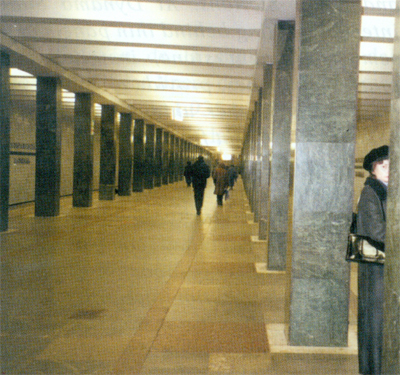
On the Serpukhov-Timiryazevsk line (1991-2001) there are not so many successful architectural solutions incorporating natural stone. Indeed there are instances where the unskilled use of stone, without taking its decorative properties into account or the overall artistic concept of the interior, has led to an antithesis of the required effect - leading to negative associations on the part of the viewer / passenger. For example, a broad band of black Agur marble above the snow white passenger tunnel walls at Orekhovo Station could be perceived as threatening storm clouds. The highly decorative wavy smokey patterned red granite from Syuskyuansaari quarry in Karelia on the floors of underground vestibules at Tverskaya, Shabolovskaya and Tsvetnoi Bulevar Stations, against a background of white marble clad walls and pylons, gives the impression of a sea of blood left after a gang warfare battle. Fortunately these are rare examples of an unsuccessful use of marble and granite, due mainly to the lack of experience of the installers.
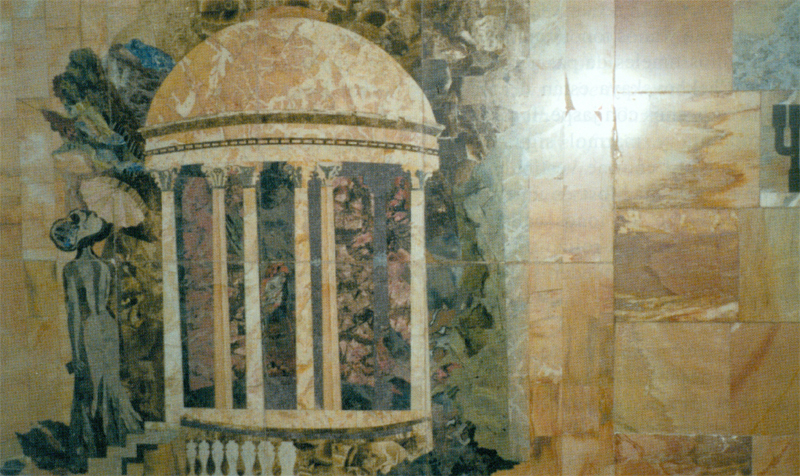
Thanks to the endless variety of colour shades, patterning and structure of the decorative stones used at stations on the Moscow Metro, a museum of "stone art" has been created which is without equal in the world. We are not talking of just a "veneer" but also a geological museum comprising several dozen varieties of rocks from more than 100 quarries. A far from complete list includes marble, dolomite, hard limestone, limestone, ophicalcite, onyx, travertine, serpentinite, granite, granodiorite, diorite, syenite, gabbro, anorthosite, gabbro-diabase, labradorite, basalt, teshenite, migmatite, gneiss, felsite tufa, quartzite, jasper, rhodonite, amazonite and wollastonite skarn. The walls and columns of the Metro stations are not just a "silent school" of aesthetic education, but also a school which could provide the basics of mineralogy and petrography within a fascinating historical-architectural framework.
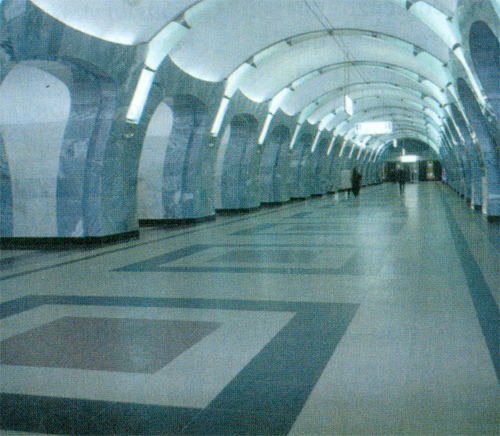
As one might imagine, keeping the stone floors and stairs clean is a job in itself. About 1000 workers are employed for these tasks. Cleaning of the decorative stone on the Moscow Metro is done every night, and at most larger stations the floors and stairs are cleaned two or three times every 24 hours.
Every year 2 - 3 new stations enter service. And decorative stone will be installed at practically all of them. Where can anyone obtain more information about the decorative stones used on the Moscow Metro? Unfortunately even for Russian speakers there is currently no reference source in print. Hopefully a new guide book will become available one day.
Translation by Paul Daniel
